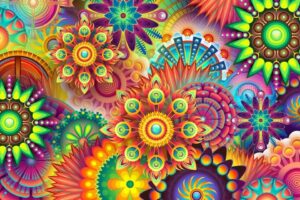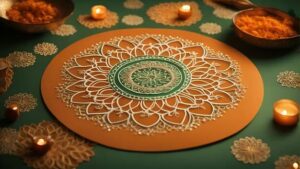Knowing the many types of mandalas and their meanings opens your eyes to a world of intricate patterns and profound symbolism. Mandalas are timeless captivating artworks that transcend mere aesthetics.
A mandala is a piece of art composed of geometric patterns and symbols. These delightful artworks are highly symbolic in Buddhist and Hindu cultures.
This article offers a comprehensive breakdown of the numerous types of Mandalas and their meanings in terms of symbols, culture, and more.
We’ll explore their psychological effects and how to use them for healing, tranquility, and introspection.

Types of Mandalas and their Meanings through Visual Representations
Mandalas are beautiful art forms. Stones and gorgeous jewels are popular for spiritual practices. But, mandalas especially stand out.
In Sanskrit, mandala means “circle” or “center”. They are believed to represent the universe. They also represent one’s own spiritual journey from the outside of oneself inward.
Let’s look at how Mandalas symbols and representations influence the different types of Mandalas and their meanings.
1. Teaching Mandalas
Teaching mandalas helps teach about the principles of dharma and paths to enlightenment. Every shape, line, and color in teaching mandalas represent aspects of Buddhism.
Often the student creates his or her own mandala using the learned principles of design and construction.
So they project a visual symbolization of everything they have learned. Therefore, we can say that the teaching mandala is a colorful mental map of the Himalayan culture.

2. Healing Mandalas
We use healing mandalas in therapy and medication. This is because of their calming effects as they can evoke a sense of peace and balance. Also, they can help with focusing and concentration.
3. Sand Mandalas
Sand Mandalas are meticulous creations of colored sand. They signify impermanence in Tibetan Buddhism. They are swept away soon after completion to show life’s transience.
4. Labyrinth Mandalas
Labyrinth Mandalas are based on ancient labyrinth designs. We use them for introspection and discovering one’s own spiritual path.
Ancient Connections and Cultural Significance of Mandalas
Mandalas also have notable meanings across different cultures. It’s no wonder they have served as sacred tools for centuries across religions, and continents. Now let’s talk about the types of mandalas and their meaning across cultures:
- Tibetan Mandalas: Tibetan Mandalas are spiritual symbols used in Buddhism for meditation and rituals. They represent the universe, the connection of life and spirituality. They often depict deities, enlightened beings, and cosmic realms.

- Native American Mandalas: Native American Mandalas are used for healing and spiritual ceremonies. They usually showcase nature-inspired elements like feathers and animals. Hence, they represent the circle of life and love for the natural world.
- Hindu Mandalas: These mandalas are usually created during weddings, religious ceremonies, and festivals. Hindu Mandalas usually depict deities, symbols, and geometric figures. They’re all about spiritual enlightenment and cosmic energies.
- Celtic Mandalas: Celtic Mandalas feature intertwined patterns, symbolizing infinity and the Cyclical nature of life. Often the Celtics use them in rituals and storytelling. They serve as visual aids to connect with the ancestors and invoke deities. They are also used to tell visual stories during notable celebrations.
In essence, mandalas are more than beautiful patterns. They’re circles of life, unity, and harmony. They echo the heartbeats of different cultures and spiritual beliefs. Even as they are easy on the eyes, they have rich and meaningful depths.

Psychological Impact of the Different Types of Mandalas and Their Meanings
Beyond their cultural meanings, mandalas also have surprising powers to influence us psychologically. Let’s look at the psychological effects across the three main types of mandalas:
- Healing Mandalas: the most common way is meditation. The goal is to bring about a sense of calm and balance.
- Teaching Mandalas: they are tools for spiritual guidance and self-discovery. Teaching Mandalas represents the journey through life and helps focus the mind.
- Sand Mandalas: they are a Tibetan Buddhist tradition involving the creation and destruction of mandalas made from colored sand. This practice serves as a reminder of life’s impermanence.
Overall, mandalas can soothe our minds. You’ll love how they improve our focus, and reduce stress and anxiety. They also invite a sense of tranquility.
Every mandala has its unique pattern and color that dissolves our whirlwind of chaotic thoughts. They guide us towards an oasis of serenity and self-awareness.
So whenever you see a mandala, remember that that gorgeous artwork can be the gateway to understanding our inner selves and the world around us.

The Unique Interpretive Flexibility of Mandalas
There’s a whole universe of mandalas out there waiting to be explored! But one thing you’ll especially love is that their meanings aren’t rigidly defined. First, we already know how they vary from one culture to the next.
But you might not already know that we can also interpret their patterns and colors based on our experiences, emotions, and subconscious mind.
For instance, a red circle evokes passion for one and anger for another. Also, the act of coloring, creating, or observing a mandala can be a part of the interpretation process. And, the purpose behind creating or engaging also influences its interpretation.
Let’s take a stroll through the garden of mandalas and unearth their intriguing interpretations.
First, stop and admire the Tibetan mandalas. These are created using colored sand and symbolize impermanence. They remind us that nothing in life is permanent. What a grounding truth, isn’t it?
Next, take a look at the Hindu mandalas. With their square within a circle representation, they often signify unity and harmony. They invite us to consider how we fit into the grander scheme of the universe.
As we walk further, you’ll see the Carl Jung-inspired mandalas, designed around the idea of ‘Self.’ These mandalas exist to guide us on a journey of self-discovery and personal growth.
So, you realize that no matter how simple and similar, each Mandalas holds a different meaning.
Like a good painting, their interpretations can be flexible. They vary from one viewer to another, each resonating with different personal experiences. So, yes there are some general meanings. But, remember that there’s always room for your own interpretation. Think of mandalas as mirrors reflecting our inner selves.

Symbolic Interactions: Colors, Shapes and Stores Intertwined
Mandalas especially find use in art therapies and spiritual practices. So it isn’t surprising that they hold a unique magic in their symbolic interactions.
These circular symbols act as intricate narratives where individual elements like colors, shapes, and patterns weave a tapestry of meaning that transcends their identities.
Here’s how symbols within mandalas interact to create deeper meaning:
- Harmony and unity: the very form of a mandala, the perfect circle symbolizes wholeness and interconnectedness. Individual elements within the circle despite their differences, contribute to the sense of harmony and unity. This interaction reflects how everything in the universe and within ourselves interconnects.
- Color conversations: colors within a mandala do not exist in isolation. Their placement, relationship, and interaction create narratives. For example, a fiery red placed near a calming blue one depicts passion and peace within a person.
- Shape play: geometric shapes within a mandala are not mere decorations. They hold symbolic weight. For instance, spirals might represent growth and change. In contrast, squares represent stability and structure. The interaction between these shapes can depict life’s journey, where transformation and stability coexist.
- Symbolic synergy: many mandalas incorporate specific symbols with established meanings. For instance using flowers representing life, or animals embodying specific qualities. The interaction between these symbols creates deeper layers of meaning. For instance, a lotus flower growing in a muddy pond might symbolize spiritual growth amid challenges.
- Personal Resonance: the most significant symbolic interaction happens within the observer. As we engage with a mandala, its elements interact with our own experiences, emotions, and beliefs. So it creates a unique and personal interpretation. This interaction fosters self-discovery and personal growth.
Mandalas are not just arbitrary designs. They’re a reflection of our inner self, our spiritual journey, the universe, and the interconnectedness of all life. They express complex ideas about identity, culture, and existence. All these in a simple, non-verbal manner.
You can leverage Mandalas to understand yourself better, creating a colorful pathway of self-discovery and enlightenment. We don’t just look at Mandalas, we interact with them, and in that interaction, we find peace, balance, and a glimpse of the infinite.




